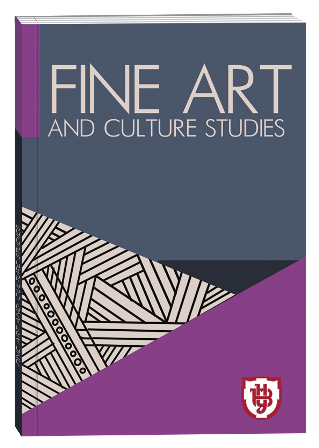METER-RHYTHMIC PROPORTIONS IN UKRAINIAN PARTES COMPOSITIONS
DOI:
https://doi.org/10.32782/facs-2022-3-5Keywords:
Ukrainian partes compositions, heritage of M. Dyletskyj, works of I. Domaratskyj, meter-rhythmic relations, proportions, baroque tempo.Abstract
The main objective of the study. The interpretation of the Ukrainian baroque choral compositions contains a lot of difficulties for a performer. One of such problems is choosing a tempo. In baroque period, the tempo was an indistinctive measurement. But there was one precise factor – its relation to the meter changes, and mensural proportions. The purpose of this article was to present all meter-rhythmic relations during the change from duple to triple time in chosen partes works, and to describe the dependence of music tempo on these factors. Methodology. Analysis was conducted to find out all features that represent the change of meter in Ukrainian baroque choral compositions. The deduction was used to collect information about the meter-rhythmic proportions in ancient treatises and establish the reasons of their application. The comparison between treatises written by the western European and Ukrainian authors was carried out to reveal the similarities in their perception of the meter changes. And modelling was used to explain the cases when each of the described proportions might be applied. Scientific novelty. The article represents the first attempt to explain scientifically how to choose different tempo correlations in Ukrainian partes works. Conclusion. The analysed Liturgy of Mykola Dyletskyj contain only one example of meter change – from ₵ to 3/1 time. So, it is possible to apply two tempo correlations: proportion tripla, or relation based on even rhythmic motives. In the compositions written by Ivan Domaratskyj we can use four different tempo correlations: two proportions, tripla and sesquialtera, may be applied to the fragments in 3/1 and 3/2 time, the relation similar to the modern meter-rhythmic norms, and the correlation, described in the Ukrainian treatise Proportion (when main beat of any triple time are equal to the crochet note of the duple time). Because of the variety of tempo correlations, the informed decision of a conductor based on his/her knowledge and practical experience plays the crucial role in choosing the right tempo for performance of the baroque composition.
References
Герасимова-Персидська Н. Хоровий концерт на Україні в XVII–XVIII ст. Київ : Музична Україна, 1978. 184 с.
Дем’яненко Б. Голосоведення у партесному восьмиголоссі як статистично стійка властивість індивідуального композиторського стилю. Українське музикознавство : науково-методичний збірник. НМАУ імені П.І. Чайковського; центр музичної україністики. Київ, 2015. Вип. 41. С. 196–221.
Дем’яненко Б. Трактат «Препорцыя» з київського рукопису XVIII століття. Укр. католиц. ун-т, Ін-т церковної музики. Серія: Історія української музики. Вип. 24: Джерела. Львів : Т. Тетюк, 2018. 44 с.
Дилецький М. Граматика музикальна: фотокопія рукопису 1723 р. / підгот. О. Цалай-Якименко. Київ : Музична Україна, 1970. 109 с.
Жукова О. Орнаментика у клавірних творах доби бароко: питання нотації. Українське музикознавство. Київ : НМАУ імені П.І. Чайковського, 2018. Вип. 44. С. 20–30.
Кузьмінський І. Витоки, музична теорія та виконавська практика партесного багатоголосся : дисертація кандидата мистецтвознавства : 17.00.03. Київ, 2014. 175 с.
Марченко М. Проблема достовірної реалізації вербального тексту партесних творів (XVII – перша половина XVIII ст.). Київське музикознавство. Вип. 53. Київ : Київська муніципальна академія музики імені Р.М. Глієра, 2016. С. 98–107.
Марченко М. Особливості вокальної манери у виконанні партесних творів: нові концепції та гіпотези. Київське музикознавство. Вип. 55. Київ : Київська муніципальна академія музики імені Р.М. Глієра, 2017. С. 224–231.
Партесні концерти XVII–XVIII століть з Київської колекції / упор., розшифр., зведення в партитуру, наук. ред., вступна ст., комент. Н. Герасимової-Персидської. Київ : Музична Україна, 2006. 340 с.
Стельмащук Р. Про деякі аспекти виконання українських партесних концертів початку XVIII століття. Старовинна музика: сучасний погляд / Ars Medievalis – Ars Contemporaris : Науковий вісник НМАУ ім. П. Чайковського. Вип. 41. Кн. 2. Київ, 2006. С. 324–330.
Фоменко Н. Дисонанс у системі виразових засобів і виконавській практиці клавірного мистецтва бароко. Часопис Національної музичної академії ім. П. Чайковського. Київ, 2020. № 2–3 (47–48). С. 151–167.
Харнонкурт Н. Музика як мова звуків. Суми : Собор. 2002. 184 с.
Цалай-Якименко О. Київська школа музики. Київ–Львів–Полтава : НТШ у Львові, 2002. 488 с.
Шабалтіна С. Деякі проблеми інтерпретації французької клавесинної музики. Науковий вісник НМАУ імені П.І. Чайковського: До 90-річчя Національної музичної академії імені П.І. Чайковського. Київ, 2003. Вип. 24: Старовинна музика, Кн. 1. С. 145–149.
Шуміліна О. Партесні концерти Герасима Левицького та інших. Актуальні проблеми мистецької практики і мистецтвознавчої науки. Київ : Національна академія мистецтв України, 2008. Вип. 1. С. 147–151.
Шуміліна О. Партесна творчість Івана Домарацького. КАЛОФѠНІЯ : Науковий збірник з історії церковної монодії та гимнографії. Львів : Видавництво Українського Католицького Університету, 2012 а. Ч. 6. С. 99–118.
Шуміліна О. Українська партесна літургія у контексті мовних традицій духовної музики XVII – першої половини XVIII століть. Українська музика. Львів : ЛНМА ім. М. Лисенка, 2012 б. Вип. 2. С. 90–98.
Donington R. Baroque Music: Style and Performance. London : Thetford Press. 1982. 206 p.
Niedt Fr. The Musical Guide. Parts 1 (1700/10), 2 (1721), and 3 (1717). / Translated by P.L. Poulin and I.C. Taylor. Oxford : Clarendon Press. 1989. 55 p.
Playford J. A Brief Introduction to the Skill of Music. London : W. Godbid. 1674.
Simpson Ch. A Compendium or Introduction to Practical Music. London : W. Pearson. 1732.
Walter Th. The Grounds and Rules of Music or an Introduction to the Art of Singing by Note. Boston : F. Franklin. 1721.







